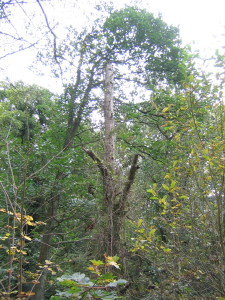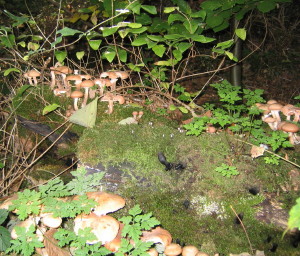 |
Nothing in the forest is ever wasted, everything is re-used.
Above- an alder tree, the top of which is decaying while the base is living. The woodpecker has observed this and year on year nested there.
|
Why is decaying wood so important?
Decaying wood is key component of a healthy woodland. It’s part of the life cycle of the tree, from seedling to maturity to old-age and decay, returning to the soil: birch up to 100 years, ash 250 years, oak 500 years.
* There can never be enough. A natural forest has prodigious quantities, standing and fallen. All woodland in Britain is grossly under provided.
* Decaying wood provides food and shelter for numerous critters (insects, slugs, spiders, centipedes, worms and many more), food for woodpeckers and others, it returns nutrients to the soil and more. Without decaying wood there’d be no fungi.
* Nature requires huge quantities of decaying wood for a woodland to be healthy, more than any I know in Britain!;
* This process is activated by numerous fungi, some of which breakdown the wood tissues and others which are symbiotic with the roots of tree, shrubs, plants, etc, exchanging nutrients for sugar acquired through photosynthesis.
* Fungi generally only ‘attack’ stressed trees not those that are healthy. Stressed, ie commencing decay, are very important to the woodland the felling of which damages the woodland community; Honey fungus (Armillarea mellea), a black cobweb under loose bark does not kill trees but rather selects the weak ones and is natures way of accelerating the natural selection;
* Each tree species decays in a different way serving a diverse purpose. Birch (Betula spp.), for example, rots quickly and is contained within the enclosing bark. The wood is thus easily excavated by woodpeckers nest building. The following winter in a gale the tree is likely to snap off at this point. Ash (Fraxinus excelsior) is another which, having topped the tree, the wood decays by the second spring for the woodpecker to excavate a nest. Oak (Quercus spp.) has a heartwood that is so hard it decays over decades;
* It is important that there is a great diversity of decaying wood - on the woodland floor, in the branches, standing trunks and cavities, etc. Nature also requires a great variety of sizes, from large logs to branches and twigs, thus creating a diversity of habitats;
* It is probable that each of decaying tree has different species of insect.
Can somebody please contribute
....
|





